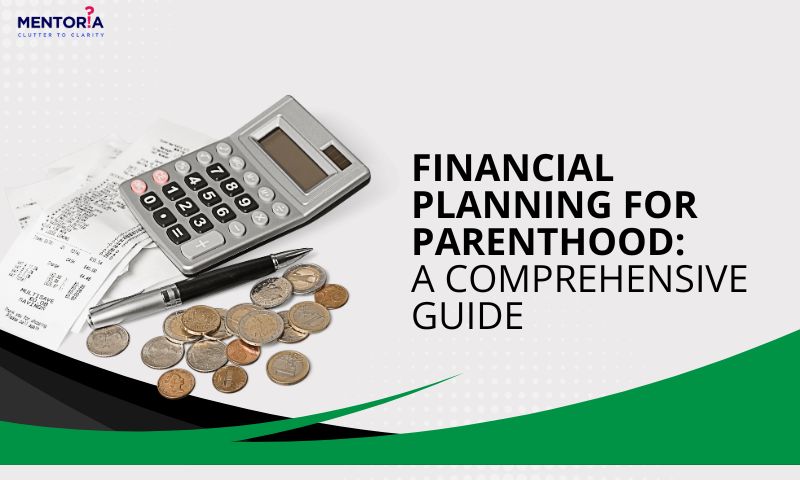Financial Planning for Parenthood: A Comprehensive Guide

Getting started with the journey of parenthood is undeniably exhilarating, filled with moments that go beyond diaper changes and sleepless nights. However, amidst this rollercoaster ride of being parents, there’s another very crucial aspect that takes centre stage – financial planning. In this guide, we’ll unravel the intricacies of preparing your finances for the exciting roller coaster ride of raising a child. So, let’s start.
The Financial Landscape
As individuals, planning our finances is challenging, but throw a family into the mix, and it’s an entirely different ball game. In an age where inflation outpaces income growth, sailing through the financial river without a plan can lead to turbulent waters. It’s not merely about crunching numbers; it’s about making informed decisions that align with your family’s goals and unique constraints.
Let’s begin with a rule many swear by – the 50-30-20 rule. Allocate 50% of your disposable income to needs and 30% to wants, and save and invest 20% for the future. This rule is paramount when you enter parenthood, where unforeseen expenses can disrupt your financial equilibrium.
When to Start Financial Planning as Parents
Ideally, the financial planning process should start very early, as early as when you plan your child. Why? Because when that little one arrives, they’ll be taking over not just your mental and physical space but also a significant chunk of your financial landscape. So, it’s crucial to sit down and map out your current income and expenses early on. This isn’t just a suggestion—it’s a must-do. Understanding where your money goes each month sets the stage for identifying areas where you can cut back and optimise
Also, if you start early, you will have the advantage of compounding. You can build a significant corpus by the time your child needs money for higher education or their wedding, and you’ll be prepared for any eventuality.
Next, an essential thing is that financial planning for parenthood should not be the sole responsibility of one partner. Both individuals in the partnership should actively engage in this crucial exercise. Embracing financial planning as a joint exercise ensures a holistic perspective, benefiting from each partner’s unique strengths.
Breaking Down the Costs
Now that we’ve set the ground rules let’s dissect some essential numbers that demand your financial attention as parents. It’s always better when we know what we are dealing with. Having a spreadsheet with all the numbers laid out gives you a starting point.
Now, write down all the major expenses that are bound to happen in the coming year. The first significant expense would be childbirth (ranging from Rs. 15000 to 1,50000). Even with insurance, new parents can expect hefty out-of-pocket payments. Contact your insurance company, understand coverage limits, and check if your preferred doctor and hospital are in-network.
The rest of the significant costs would be healthcare, education, and general living costs; the numbers can add up swiftly. Kindergarten fees alone can range up to Rs. 1.2 lakhs and beyond, depending on your location and lifestyle. As your child grows, education becomes a constant financial companion. The expenses can mount from choosing the right school board to considering coaching classes, summer camps, and other extracurricular activities.
To put these numbers into perspective, let’s explore a breakdown of expenses for a middle-class family living in Mumbai. It’s a costly city, and the school fees alone can hit 1.72 lakhs annually. Add extracurricular activities, summer camps, clothing, medical expenses, and a SIP for his higher education, and you’re looking at an annual expenditure of close to 2.6 lakhs for an 8-year-old child. Accordingly, you can also make your spreadsheet to start planning for them.
Inflation: A Game-Changer
One crucial factor often overlooked in financial planning is inflation. Remember your parents used to manage an entire household on a Rs. 20,000 per month salary. Today, that’s barely enough for rent in a metro city. Inflation can significantly impact your long-term financial goals, especially in areas like medical expenses and higher education.
To drive the point home, consider the inflation rates. Higher education costs surge at 11% per annum, so today, if sending your kid for higher studies abroad to the US costs you 2.7 Crores, it will be about seven Crores after ten years. Likewise, medical expenses inflate at about 14% every year. Planning for these expenses requires saving and factoring in inflation rates to ensure your investments withstand the test of time.
Short-Term Financial Investment
With the reality of costs sinking in, let’s shift gears to practical solutions. Short-term financial goals demand immediate attention in the next year or two. Expenses like school admission fees, healthcare and hospital expenses, fees for extra classes, family vacations fall under this category and it’s important that we have an auto swipe savings account especially for them .However, there are some of the other investment tools that can help you to handle these expenses.
We will talk more about these investment funds but before that it’s important to understand that the rate of return keeps changing for all kinds of investments, so you must talk to a financial expert to get correct information about ROI and risk factors before investing.
Debt Funds
For short-term goals, consider debt mutual funds—a low risk with consistent returns, perfect for covering recurring expenses like school fees or medical emergencies. Various financial institutions offer a return on investment (ROI) of slightly over 7%.
Recurring Deposits
Opt for recurring deposits spanning six months to 10 years, with monthly, quarterly, or semi-annual payment options. Interest rates vary across banks, so thorough research is critical.
Post Office Time Deposits
Ideal for one-year investments, Post Office Time Deposits offer an attractive interest rate ranging from about 6.90% to 7.50% for one to five-year plans. Withdrawal is possible after six months if needed.
Gold
Investing in gold proves promising for both short and long-term durations. Over the years, gold has shown remarkable growth— a testament to its enduring value. Explore gold bonds for added investment avenues.
Fixed Deposits (FDs)
Traditional yet reliable, opening fixed bank deposits remains a conventional option for one-year investments—research interest rates across banks for optimal returns.
Corporate FDs
Consider Corporate FDs from NBFCs like Bajaj Finance and Shriram Transport for potentially higher returns than standard bank FDs. Consult a wealth manager for specialised advice.
Corporate Bonds
Diversify with corporate bonds offering varying risks and returns. High-quality bonds with minimal risk may yield 7-8.5% returns, while secured bonds, though slightly riskier, may provide higher returns. Seek professional guidance for informed decisions.
Long-Term Financial Investment
Long-term financial goals will be incurred after 15 to 18 years. These expenses include retirement planning, higher education, children’s weddings, and ensuring financial security for them. So here are some of the investment tools for these expenses.
Equity Mutual Funds
When it comes to long-term financial goals like securing your child’s education or ensuring a dream wedding, Equity Mutual Funds are your go-to. Through Systematic Investment Plans (SIP), investing for 10-15 years can be a game-changer. If you invest monthly for 18 years, you may get a 12% annual interest rate; you can beat the 5-6% yearly inflation rate, making SIP a stellar long-term investment plan. However, it does come with its risk factors.
Unit Linked Insurance Plans
ULIPs bring together insurance and investment. A fraction of your investment secures your life while the remainder ventures into the market, promising higher returns over 15 years.
Real Estate
Despite a slowing return on investment in real estate, diligent research can uncover hidden gems, especially in developing cities. Experts advise land investment over houses, emphasising the need for careful exploration before committing substantial investment into real estate.
Government Schemes
Government schemes like PPF (Public Provident Fund) and Sukanya Samriddhi Yojana offer not only long-term financial security but also tax benefits, making them prudent choices for planning your child’s future.
Stock Exchange Investment
Investing in stocks of reputable companies for the long run is safer than engaging in day trading. The stock market, though with higher risk probability, can be a valuable addition to your investment portfolio with proper knowledge or guidance from a trusted broker.
Diversify Your Investments and Regular Reviews
Now, one golden rule in investment is to not put all your eggs in one basket. It helps you in balancing risks and rewards. Whether you’ve invested in land or SIP, diversifying your investments helps manage risk and liquidity effectively.
Also, Periodic reviews of your investments are crucial. If a piece of land has peaked, consider selling it and redirecting the funds, perhaps into the stock market. This dynamic approach ensures your money grows optimally over time.
How Mentoria Can Help
Parenthood is undoubtedly a financial marathon, not a sprint. Navigating the twists and turns demands a mix of strategic planning, informed decision-making, and a diversified investment approach. As you embark on this journey, Mentoria is there to help you with choosing the right education and career path for your child according to your child’s interests and your budget. In case you need any help regarding the same don’t hesitate to contact us right away and we will take care of it completely.









